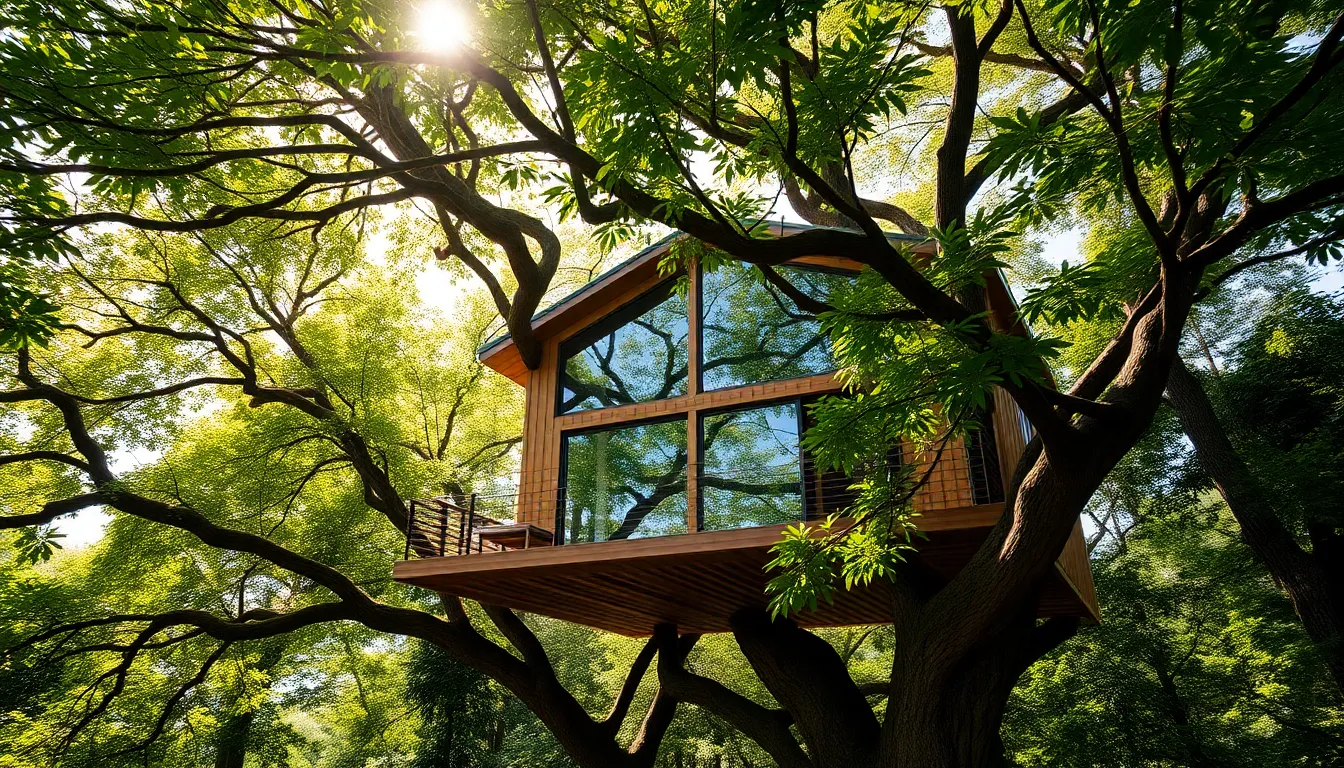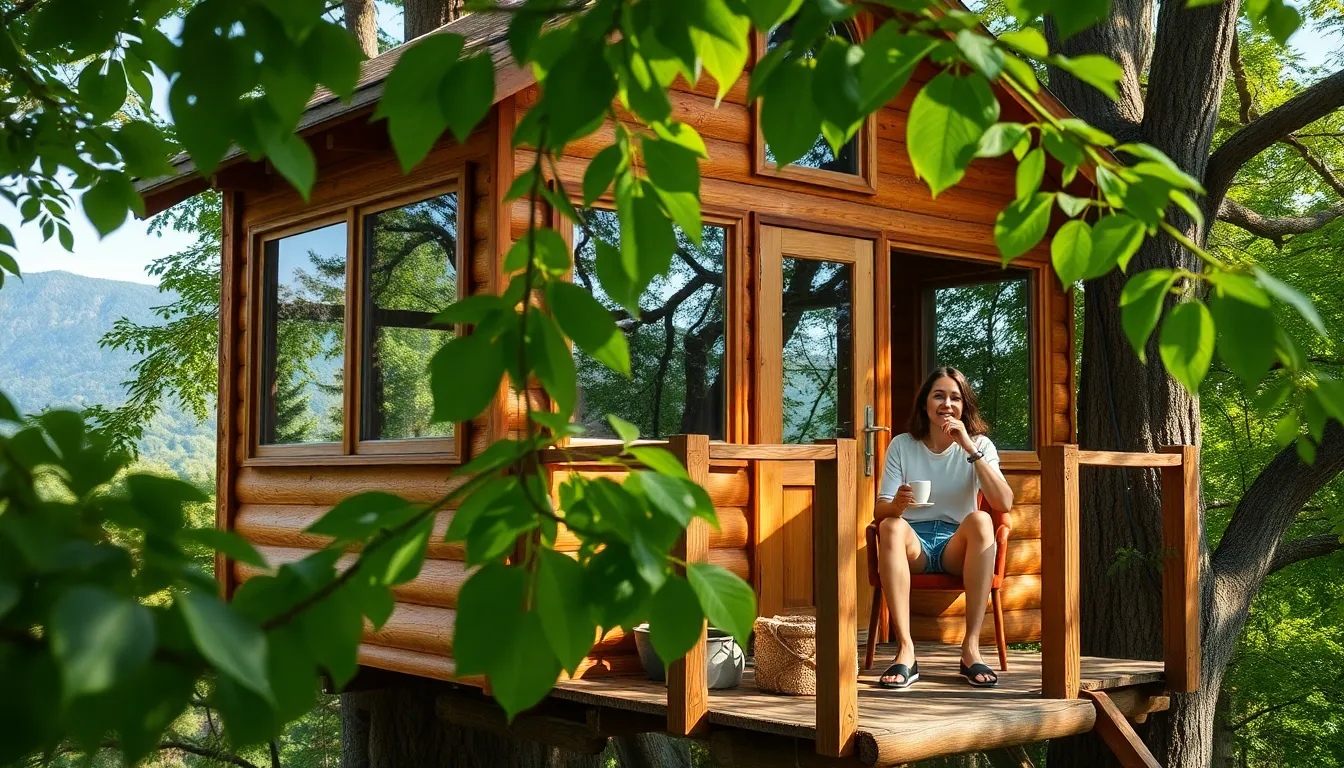Imagine sipping your morning coffee while perched high among the branches, surrounded by the gentle rustle of leaves and the sweet songs of chirping birds. Tree house architecture isn’t just for kids anymore; it’s become a whimsical blend of creativity and engineering that captures the imagination of adults too. These elevated retreats offer a unique escape from the hustle and bustle of everyday life, transforming a childhood dream into a stylish reality.
Table of Contents
ToggleOverview of Tree House Architecture
Tree house architecture blends creativity with engineering, creating elevated spaces that function as retreats. Historically, tree houses served as whimsical play areas for children. Today, they represent sophisticated designs, often featuring modern amenities. Architects employ innovative techniques to integrate tree houses into their natural surroundings.
Design concepts vary widely, ranging from minimalist structures to luxurious retreats. Many examples showcase sustainable materials, reinforcing environmental responsibility. Structures often utilize trees as integral support systems, ensuring stability while maintaining a connection with nature. Features like large windows optimize views, inviting sunlight and natural elements into the space.
Incorporating modern technology enhances the usability of tree houses. Solar panels may power lighting and appliances, while smart systems control climate and security. Each design often reflects the owner’s personality and lifestyle, resulting in unique spaces tailored to individual needs.
Accessibility is another consideration in tree house architecture. Some designers incorporate ramps and ladders to accommodate various age groups and mobility levels. Safety plays a crucial role in the design process, with railing and secure entry points ensuring users can enjoy their spaces without concern.
The resurgence of interest in tree houses can be attributed to the growing desire for unique experiences in nature. They provide an escape from urban living, allowing individuals to reconnect with the environment. Tree house architecture continues to evolve, promising exciting possibilities for future designs.
Historical Significance

Tree houses possess a rich historical significance, intertwining creativity with tradition.
Ancient Tree Houses
Ancient cultures utilized tree houses for protection and connection with nature. In Southeast Asia, the Iban people built longhouses elevated in trees, fostering community life and safety from floods and predators. Similarly, the indigenous tribes of the Amazon constructed platforms among the canopy, creating spaces for living and rituals. These structures maintained harmony with the environment while providing shelter from environmental threats.
Modern Interpretations
In contemporary settings, tree houses reflect architectural innovation and sustainability. Architects today design tree houses as modern retreats, emphasizing eco-friendliness and harmony with nature. They incorporate sustainable materials and integrate smart technology for energy efficiency. Urban tree houses often serve as unique accommodations, offering experiences that reconnect people with nature. Increased interest in these structures highlights a desire for escape from conventional living, where individuals immerse themselves in tranquil surroundings.
Design Principles
Tree house architecture prioritizes harmony with nature and sustainability, creating inviting, functional spaces. Designers emphasize integrating these structures seamlessly into their environment.
Integrating Nature
Integrating tree houses into their surroundings enhances the overall experience. Architects often choose trees that naturally support the structure. This method allows for unobstructed views of the landscape. Large windows are positioned strategically to optimize light and scenery. Local flora is often incorporated into the design, creating a seamless transition between indoor and outdoor spaces. Residents enjoy the sensation of living among the trees, reinforcing their connection with nature. Natural materials enhance this synergy, providing a cohesive aesthetic and feel.
Sustainable Materials
Sustainable materials play a crucial role in modern tree house design. Reclaimed wood is frequently used, reducing waste and preserving resources. Manufacturers offer eco-friendly alternatives like bamboo and composite materials, known for durability and minimal environmental impact. Designers select non-toxic finishes and paints, ensuring a safer living environment. Integrating solar panels and rainwater harvesting systems promotes energy efficiency and responsible resource management. These sustainable choices reflect a commitment to environmental stewardship while providing functional and aesthetically pleasing spaces.
Popular Tree House Styles
Tree house architecture boasts various styles that cater to diverse aesthetics and functions. Each style encapsulates a unique relationship with nature and the surrounding environment.
Rustic Tree Houses
Rustic tree houses often celebrate natural materials and traditional craftsmanship. Wood forms the primary construction material, enhancing warmth and inviting textures. They blend seamlessly into the forest, creating a harmonious relationship with trees and wildlife. These structures frequently incorporate elements like exposed beams, wooden ladders, and large porches. The simplicity of design focuses on functionality, making these tree houses accessible while preserving the charm of a bygone era. Such designs evoke nostalgia, offering a retreat that emphasizes connection with the great outdoors.
Contemporary Designs
Contemporary tree houses embrace modern aesthetics and innovative building techniques. Sleek lines and minimalist forms characterize their distinct look. Large windows invite natural light, providing breathtaking views of the surroundings. Sustainable materials play a crucial role, including recycled metals and eco-friendly finishes that minimize environmental impact. Advanced technology integrates seamlessly, with smart home systems enhancing comfort and security. Designers prioritize sustainability, often incorporating solar panels and rainwater systems. Contemporary tree houses redefine the traditional concept by focusing on modern living while fostering a connection with nature.
Benefits of Tree House Living
Tree houses offer remarkable advantages, enhancing daily life through unique experiences and architectural innovation.
Connection to Nature
Living in a tree house fosters a profound connection to nature. Residents enjoy the sights and sounds of the outdoors, engaging directly with the environment. This immersive experience promotes mental well-being, with studies showing nature exposure reduces stress and improves mood. Many tree houses feature large windows or open decks, blurring the lines between indoor and outdoor living. With trees as the foundation, individuals find themselves surrounded by vibrant foliage and wildlife. Experiences like watching birds or simply enjoying a sunrise cultivate an appreciation for ecosystems. The tranquility of tree house living encourages mindfulness and relaxation, making nature an integral part of daily routines.
Unique Living Spaces
Tree houses create distinct living spaces that stand out from traditional homes. Their elevated structures provide stunning views, offering perspectives not found at ground level. Custom designs allow occupants to tailor their homes to personal tastes, incorporating features like balconies or unique architectural elements. Space utilization often prioritizes open layouts, maximizing the interior experience while maintaining a cozy atmosphere. Integration of sustainable materials means tree houses can demonstrate eco-friendliness while showcasing craftsmanship. These unique living environments stand as symbols of creativity and freedom, appealing to those seeking an extraordinary lifestyle. Each tree house serves as a personal sanctuary, reflecting individuality and a connection to the natural world.
Tree house architecture stands as a testament to human creativity and the desire to connect with nature. With its rich history and modern innovations, these structures offer more than just a retreat; they provide an immersive experience that fosters well-being and mindfulness. As architects continue to push the boundaries of design and sustainability, tree houses are poised to become even more integral to eco-friendly living. Their ability to blend seamlessly into the environment while offering unique living spaces reflects a growing appreciation for the harmony between architecture and nature. This enchanting trend invites everyone to explore the possibilities of living among the trees.




